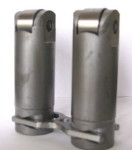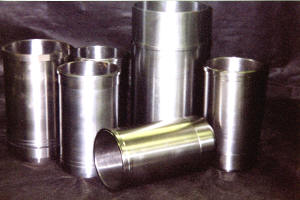Cylinder Honing
What is honing, how is it performed and why is it important? Honing is an abrasive process thatimproves the surface finish, size, and roundness of a bored cylinder/sleeve. Honing is done tomaximize ring seal, piston ring and cylinder wall longevity. The purpose is to create as close toan ideal surface as possible to mate with ring faces.
Optimal ring sealing is the goal of proper cylinder finishing and it is critical for maximum powerproduction. Torque, horsepower and oil consumption are directly affected by the finish on thecylinder walls. Hidden costs are horsepower potential never realized and horsepower producedthat is consumed by parasitic losses. Blow-by, windage, ring flutter, oil contamination and pistonskirt scuffing are examples of parasitic loss. These hidden costs are very real.
What’s happening inside your engine.
Piston rings seal the gap between the piston and cylinder enabling cylinder pressure to beconverted into work. Application specific rings mated to properly honed and sized cylinder wallsallow engine oil to create a barrier of oil captured between the ring face and the cylinder surface. A film of oil seals cylinder pressure, prevents metal to metal contact, and transfers 20% of combustion heat from piston to ring to cylinder wall and then into the cooling system. It is the barrier that separates success from disaster. In an engine with a 5.0” stroke running 6,000 rpm, the average piston speed is 83.33 ft/second or 56.83 mph. The ring must seal very high peak cylinder pressures (over 4000 PSI), maintain that seal while cylinder pressure drops as the piston moves toward bottom dead center, survive the heat of combustion (in excess of 5000 F.), withstand the surface friction of those speeds and provide a low friction ride back to top dead center. Obviously, metal to metal contact between ring face and cylinder would lead to catastrophic failure in several engine revolutions.
Increased combustion pressures (higher boost) increase bore distortion and heat transferrequirements. Typical boosted engines can experience leakage of over 5%. Lost pressure meanslost potential horsepower. A false economy solution to blow-by is to add more boost which inturn creates a larger cycle of loss. Thus ring seal is critical in capturing the increased cylinderpressure generated by improvements to camshafts, induction, combustion and exhaust systems.
Major factors in cylinder preparation.
Size:
Size may sound simple but size is as complicated as surface finish. Size is relative to taper and out-of-round. Sizing a sleeve or cylinder has a number of issues to consider. Is the size determined by maximum or minimum measurements recorded? How are these measurements taken? How cylindrical (close to absolute round and size over its entire length) is the bore? At what temperature was it measured?
Surface Finish:
Crosshatch is important for ring seal and ring life. The required angle is determined in part by thesleeve or block material. A narrow (flat) cross hatch angle can allow excessive ring rotation andresultant ring and piston ring land wear. A steep cross hatch angle allows a loss of oil film retention, inconsistent ring seal and reduced ring rotation leading to increased cylinder wear. Of all the possible distortions, out-of-round is more important than taper for ring seal and ring life.
The “smoothness” as most individuals would call it is important. Application dependent, it effects ring break in time, and ring and sleeve wear.
What Happens is size, and surface finish are poor?
First, the ring is distorted and contact pressure between cylinder wall and ring face oil film is unevenly distributed. Second, if enough ring face contact is lost the ring can flutter against the cylinder wall. The ring then loses cooling capability allowing even more leakage and increased wear on the piston ring grooves. Third, the hot combustion gases can “wipe” away the oil film below the ring creating less ring seal and heat transfer capability. If severe enough, combustion gases leakage can blow past the secondary and oil rings which induces piston skirt scoring.
Blow-by is the result of deficient ring seal and creates crankcase pressure which increases windage. This mixture of oil and combustion gases forms a “slurry” that surrounds and rotates with the crankshaft. The parasitic loss of power due to rotating this extra mass is measurable.
Solutions
Honing sleeves in the block allows finish honing with a minimum of out of round and taper. A seasoned block will have thousands of running time hours and heat cycles. It has moved, shifted and distorted in all areas. It has been stress relieved and stabilized.
Qualifying a seasoned block, re-machining as needed, and then honing the sleeves in place will provide the most distortion free method of preparing sleeves for assembly. By installing sleeves in the block, serializing and clocking each sleeve to its position, and using a torque plate, the sleeve will distort as it will be in the final assembly. Accurate machines with rigid spindles, correct honing tools, cutting lubricants, combined with operator skill and adequate measuring tools are all required to produce a round bore at specified surface finish and at precise size.
However, despite using the best procedures and equipment, the cylinder bore changes when the engine is assembled. Head bolt loading, sleeve counter-bore alignment in the top of block relative to the bottom of the block,counter-bore depth uniformity and flatness, consistent sleeve flange height, block deck flatness and cylinder head flatness all affect cylinder bore distortion when assembled. Good block
inspection and re-machining as needed, quality sleeves and proper head bolt torque proceduresduring assembly will help reduce distortion.
We can inspect, correct, and prepare your block for in-place sleeve honing. Once we have a clean block and inspection is completed, a reconditioning cost is calculated and sent to you for approval. We will mark each sleeve and the block for sleeve position and rotation, install torque plates and finish hone oursleeves, or the bores in un-sleeved blocks. Upon completion, we clean the block of honing oil and grit. Then we provide you an inspection report of the size and condition of each bore/sleeve.
When shipping the block to us is impractical due to cost or time, choose our fixture finished sleeves. You gain the convenience of quicker delivery. Our fixtures are made to resemble the block in height and location of counter-bores, o-ring grooves, etc. and use a full perimeter clamping plate to simulate installation in a block. Our fixtures are machined on a CNC machining center for accuracy and we use o-rings as used in the block.
Good block preparation, matching ring type to bore finish, round and straight sleeves when installed and engine assembled, meticulous cleaning and good assembly procedures will give you the best performance for the money. The tangible benefits realized are increased horsepower, durability and consistency. Now that is the best “Bang for the Buck.”


